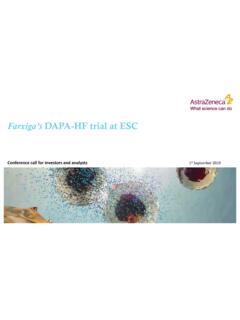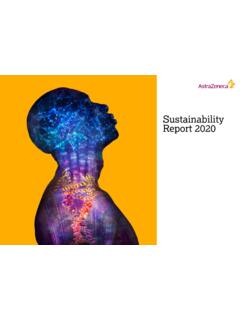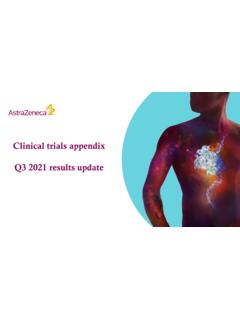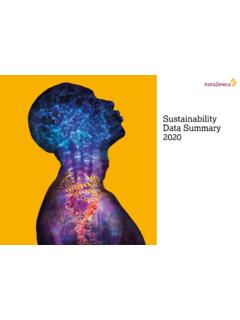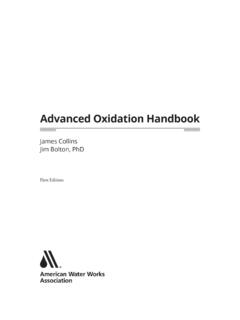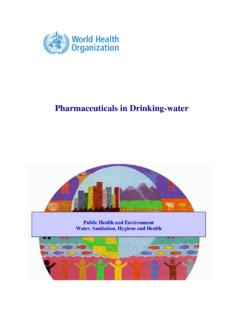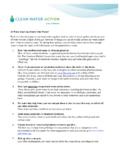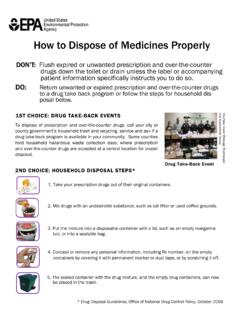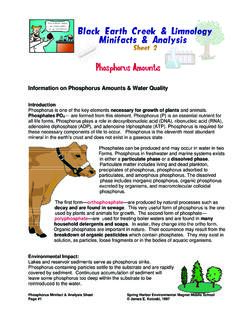Transcription of Pharmaceuticals in the Environment - AstraZeneca
1 11 Pharmaceuticals in the EnvironmentAs a responsible healthcare company, we are committed to the health and safety of our society and planet. We make it a priority to effectively manage the risks associated with Pharmaceuticals in the Environment (PIE).2 Pharmaceuticals enter the environmental mainly as a result of patient use, where they can pass through our bodies and into waterways. Drug manufacture and the improper disposal of unused medicines also add to the trace levels of Pharmaceuticals in rivers, lakes, soils, and, sometimes, drinking water . AstraZeneca recognises that, even in such low concentrations, the risks associated with Pharmaceuticals in the Environment (PIE) should be determined, minimised and managed.
2 How do pharmaceutical Products get into the Environment ? AstraZeneca supports actions based on scientific evidence to address the challenges presented by PIE. These include: Assessing the environmental risk of our medicines to support drug marketing authorisations Actively managing the environmental risks resulting from our manufacturing Supporting industry and government efforts to improve medicine disposal programs and education Co-sponsoring research to fill scientific gaps to understand and mitigate the risks of learn more about the risks associated with PIE and what we are doing to manage them please click in the environment88%as a result of patient use 2%attributed to waste from production10%from unused medicines that people don t dispose of properly3 Trace amounts of Pharmaceuticals have been
3 Detected in the Environment for more than 20 years. As environmental monitoring expands and the methods for measuring Pharmaceuticals in the Environment become more sophisticated and detection limits get better, the geographical scope and number of Pharmaceuticals measured in the Environment will grow. We also recognise that these concerns will increase with improved access to medicines and an ageing population where more patients will pass pharmaceutical residues into the Environment . In most cases, environmental monitoring demonstrates that PIE resulting from patient use poses low or insignificant Environment risk and the presence of these trace levels does not cause a problem.
4 However, there can be some location-specific environmental risks for some particular Pharmaceuticals , especially in regions where there may be inadequate sewage treatment, high populations of people and rivers with low flow conditions. We need to be sure we have tools to identify these at risk situations and to devise appropriate solutions. The issue of PIE is gaining attention outside the scientific community, with increased scrutiny from media, governments, regulatory agencies, and investors. The concerns about PIE have been recognised by the United Nations Environment Programme and the World Health Organization (WHO) within its Strategic Approach to International Chemicals Management, where Environmentally Persistent pharmaceutical Pollutants (EPPP) has been included as an emerging policy issue.
5 For more information on EPPP click Concerns about PIE4 There are currently no reports of adverse human health effects attributed to Pharmaceuticals in environmental waters. Studies from the World Health Organization concluded, Trace quantities of Pharmaceuticals in drinking water are very unlikely to pose risks to human health because of the substantial margin of exposure or margin of safety between the concentrations detected and the concentrations likely to evoke a pharmacological effect. Further, Concerns over Pharmaceuticals should not divert the attention and valuable resources of water suppliers and regulators from the various bacterial, viral and protozoan waterborne pathogens and other chemical priorities, such as lead and arsenic.
6 While trace concentrations of Pharmaceuticals in drinking water are very unlikely to pose risks to human health, knowledge gaps still , the risks associated with long-term exposure to low concentrations of Pharmaceuticals and the combined effects of mixtures of Pharmaceuticals and other compounds still requires further investigation1. It is generally considered that levels of Pharmaceuticals in the Environment are below those which would result in acute (short-term) effects in wildlife, including aquatic life such as fish. Ongoing, concerns that chronic (long-term) exposure to these trace levels could result in a potential risk to organisms do exist.
7 Most of these concerns focused on the potential developmental and reproductive effects of medicines that are designed to interact with the human endocrine or hormone system (for example, contraceptives, hormone replacement therapies and certain cancer treatments). It has been shown that some endocrine active chemicals can have chronic impacts on the sexual development of fish. However, these effects are not just limited to Pharmaceuticals . They have been shown to also be caused by exposure to natural hormones and other manmade chemicals present in the Environment . Further studies are needed to determine if there are any significant population-level environmental effects arising from long-term and low-level exposure to Pharmaceuticals in environmental waters.
8 There is one well known case where a non- AstraZeneca medicine has caused a population level impact on wildlife. The veterinary use of diclofenac in Asia resulted in the death of millions of vultures that fed on treated cattle. This impact was unexpected as the exposure resulted from cultural farming practices not captured in environmental risk assessment guidance and shows the importance for ongoing vigilance. There is also growing concern over the antimicrobial resistance and the role that antibiotic residues in the Environment has in causing resistance to antibiotic to Human Health and the Environment 1 WHO. (2011). Pharmaceuticals in drinking water .
9 WHO Press, Geneva, Switzerland. Link to report 5 AstraZeneca is committed to ensuring the effective environmental management of our products across the whole of the product life cycle from drug development and manufacture through to patient use and disposal. To do this we: Conduct an Environmental Risk Assessment (ERA) before the approval of a new medicine. We do this by generating environmental fate and toxicity data according to international standards. In an ERA we identify safe concentrations of a pharmaceutical . We submit the resulting data to Regulatory Authorities as formal ERA reports. The environmental risk associated with biological therapies is considered negligible and they currently require a case-by-case exemption for an ERA.
10 Make our ERA data available via our webpages and in Appendix 1 of this document. Establish safe discharge concentrations for our manufacturing operations and report our compliance against these safe discharge standards. Conduct ecopharmacovigilance (EPV) to ensure that our ERAs and safe discharge concentrations remain up to date and reflect the latest science2. Our EPV process reviews emerging science and literature, looking for new information that might change the way we assess the environmental risks associated with our APIs. Our EPV is critical in helping us to ensure the environmental safety of our products. AstraZeneca s Position Actively encourage our patients to return unwanted medicines for safe disposal through collection schemes.



